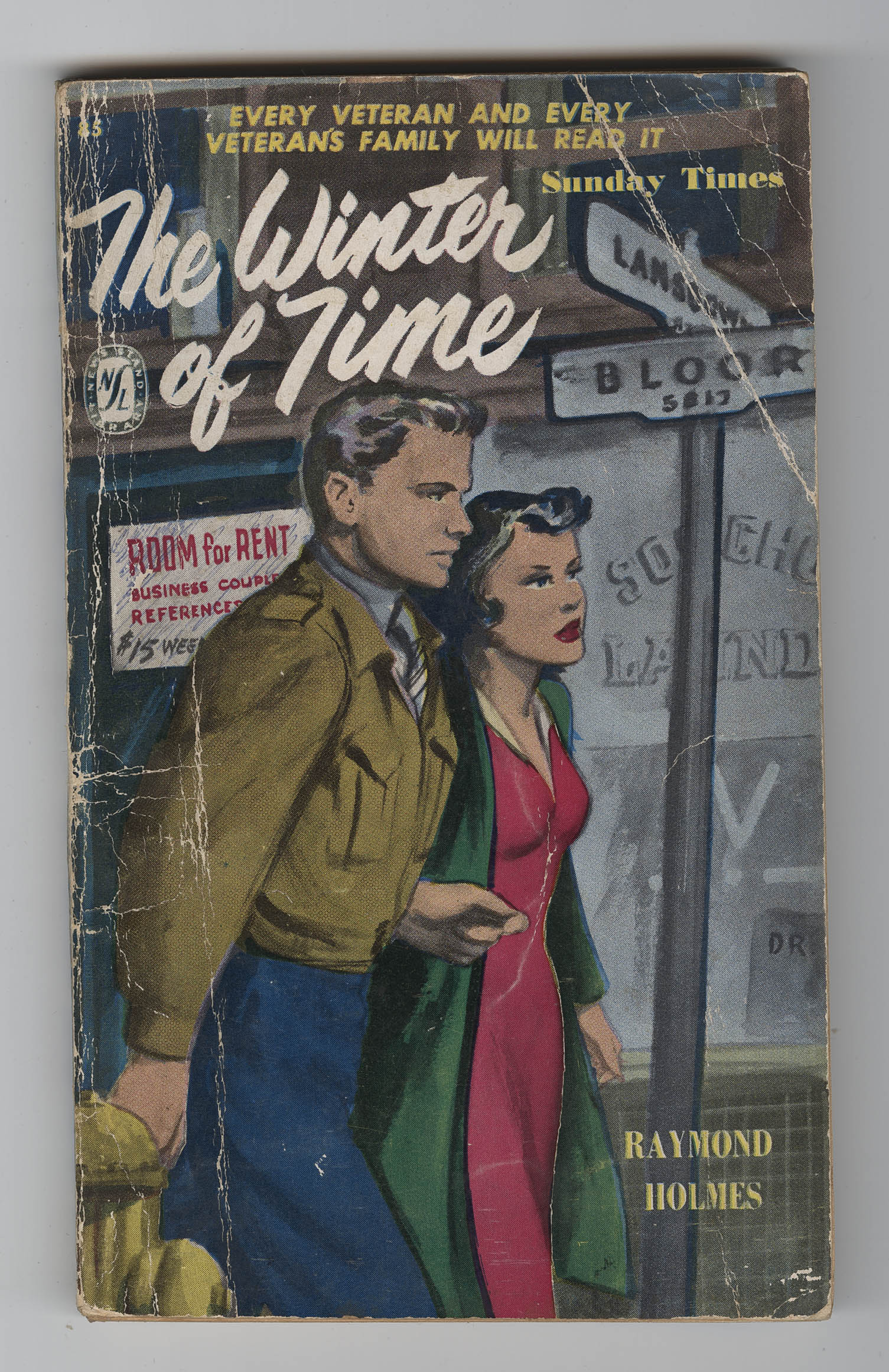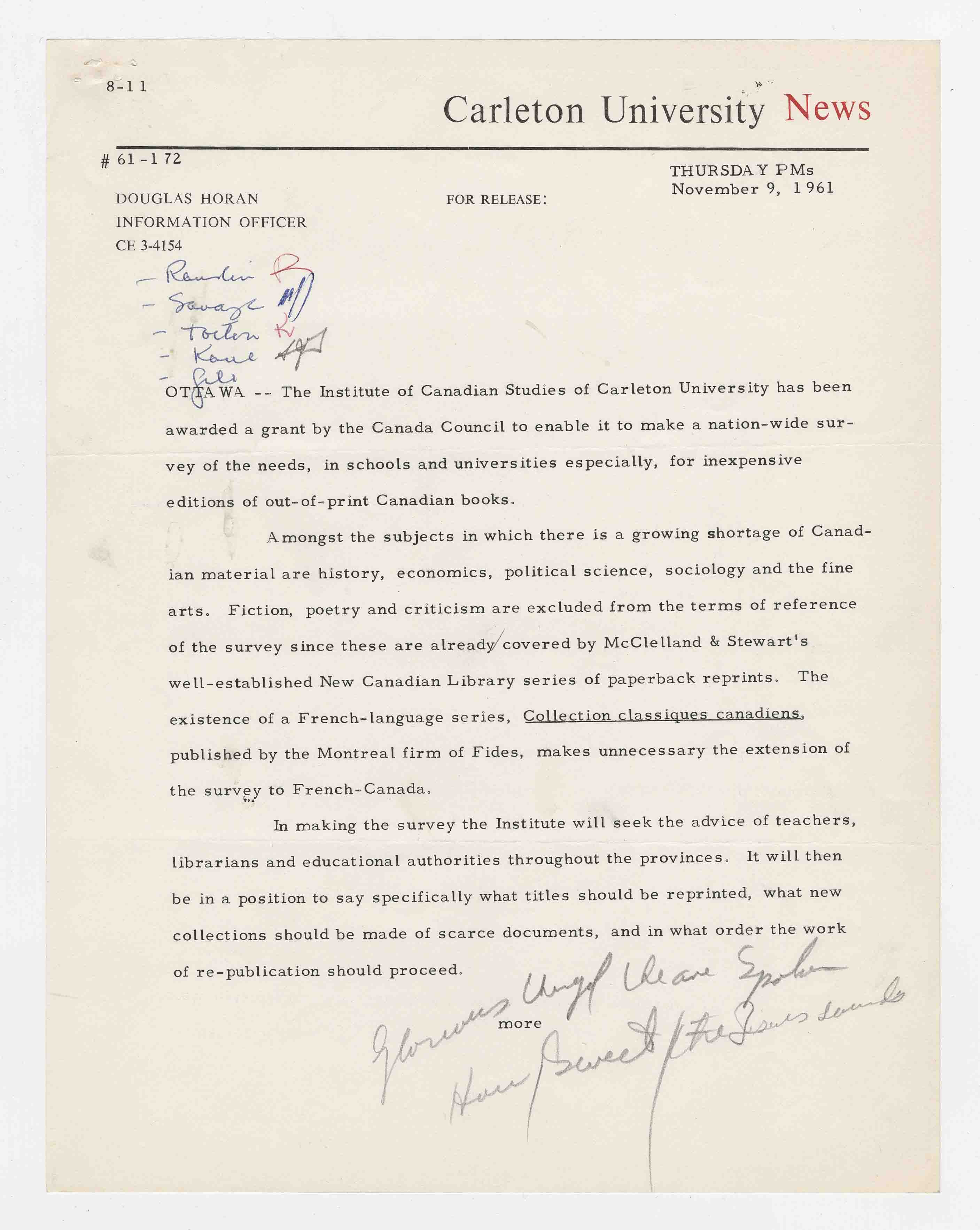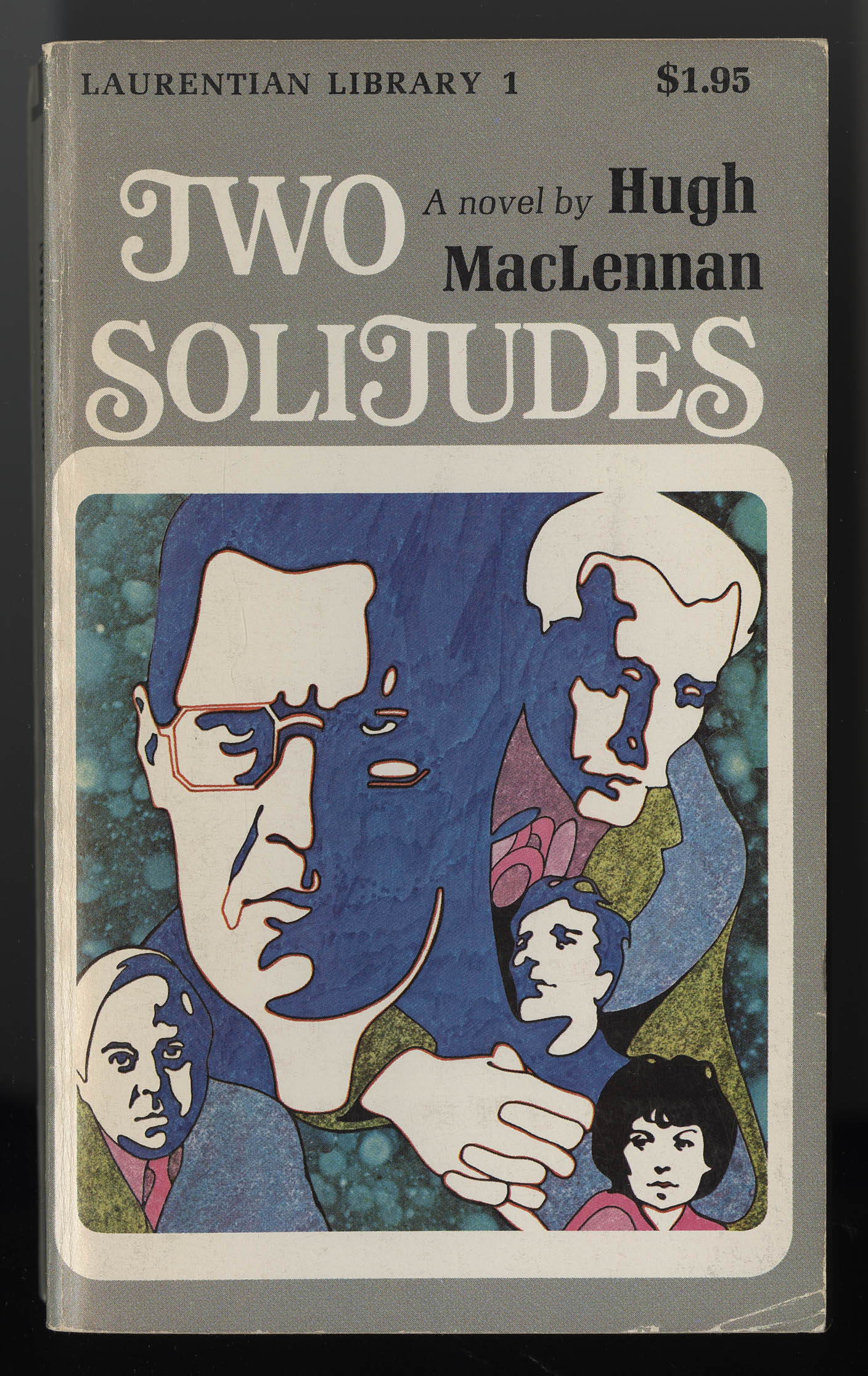The Canadian 'Pocket Book,' 1940-1980
Janet B. Friskney, Frost Centre for Canadian Studies & Indigenous Studies, Trent University
The ‘pocket book’ was a term widely used in North America during the middle decades of the twentieth century to describe the handy, pocket-sized paperbacks that came into vogue after the six-pence Penguin Book emerged in Great Britain in 1935 and the 25-cent Pocket Book appeared on American mass-market racks in 1939. Other British and American pocket book initiatives soon followed. Canada’s traditional status as an export market for both British and American publications ensured the pocket book rapidly established itself in Canada. 
Canadian publishers began issuing pocket books in the 1940s. In 1942, the Toronto branch of Collins started producing local editions of its Scottish parent’s White Circle series when war-time shipping and production problems in Britain made importation difficult. The titles issued in Canada represented only a selection of the British list, with particular emphasis on mysteries. The Toronto branch also incorporated Canadian non-fiction and fiction titles into its White Circle list, including Kate Aitkens’s The Canadian Cookbook, Stephen Leacock’s Sunshine Sketches of a Little Town, and Hugh MacLennan’s Two Solitudes. An  advertisement titled “The Boom in Books” in Quill & Quire’s June 1945 edition, shows that the books were priced at 25 cents throughout the war, and that in that year, four new titles were issued each month. Two other Toronto firms, the Duchess Printing and Publishing Company and Export Publishing, began issuing pocket-book series of genre fiction in the mid-1940s. In Quebec, the magazine La Revue moderne launched its Petit format series in 1944. This series lasted until 1958, reprinting popular novels first issued in France as well as translations of American titles.
advertisement titled “The Boom in Books” in Quill & Quire’s June 1945 edition, shows that the books were priced at 25 cents throughout the war, and that in that year, four new titles were issued each month. Two other Toronto firms, the Duchess Printing and Publishing Company and Export Publishing, began issuing pocket-book series of genre fiction in the mid-1940s. In Quebec, the magazine La Revue moderne launched its Petit format series in 1944. This series lasted until 1958, reprinting popular novels first issued in France as well as translations of American titles.
In May 1949, Canada’s most famous pocket-book firm, Harlequin, published its first titles. During its early years in Winnipeg, the firm reprinted crime fiction, westerns,  science fiction, romances, and the occasional non-fiction title. Original works also appeared, such as Wreath for a Redhead and The Executioners, two thrillers by Brian Moore. Romance titles became the firm’s primary focus beginning in the 1960s. During the 1960s and 1970s, Harlequin undertook an extraordinary move for a Canadian book publisher by expanding into the American market, and then overseas into foreign-language markets. In the present day, Harlequin maintains a strong web presence through eHarlequin.com, and distributes in Canada multiple categories of romance fiction under the Harlequin imprint (eg. Blaze, Historical, Intrigue, Presents, Romance), as well as titles from its subsidiaries Luna, Mira, and Silhouette.
science fiction, romances, and the occasional non-fiction title. Original works also appeared, such as Wreath for a Redhead and The Executioners, two thrillers by Brian Moore. Romance titles became the firm’s primary focus beginning in the 1960s. During the 1960s and 1970s, Harlequin undertook an extraordinary move for a Canadian book publisher by expanding into the American market, and then overseas into foreign-language markets. In the present day, Harlequin maintains a strong web presence through eHarlequin.com, and distributes in Canada multiple categories of romance fiction under the Harlequin imprint (eg. Blaze, Historical, Intrigue, Presents, Romance), as well as titles from its subsidiaries Luna, Mira, and Silhouette.
 Until the early 1950s, pocket books were fundamentally a mass-market format. Produced in large print runs to achieve their 25-cent pricing, these books relied heavily on the distribution networks developed for magazines. Large production runs required by the format combined with limited access to the predominantly American-controlled distribution network discouraged most publishers in English Canada from venturing into this field. A vital component of Harlequin’s early success was its partial ownership by the sales manager of the Toronto subsidiary of Curtis Distributing. By contrast, when Toronto publisher McClelland & Stewart (M&S) attempted its Canadian Best-seller Library in 1964, the experiment ended after only four years and forty-six titles. The series included works by popular authors Peter C. Newman, Pierre Berton, and Farley Mowat, but distribution difficulties, fierce competition for space in mass-market outlets and the economies of producing for the mass market defeated M&S.
Until the early 1950s, pocket books were fundamentally a mass-market format. Produced in large print runs to achieve their 25-cent pricing, these books relied heavily on the distribution networks developed for magazines. Large production runs required by the format combined with limited access to the predominantly American-controlled distribution network discouraged most publishers in English Canada from venturing into this field. A vital component of Harlequin’s early success was its partial ownership by the sales manager of the Toronto subsidiary of Curtis Distributing. By contrast, when Toronto publisher McClelland & Stewart (M&S) attempted its Canadian Best-seller Library in 1964, the experiment ended after only four years and forty-six titles. The series included works by popular authors Peter C. Newman, Pierre Berton, and Farley Mowat, but distribution difficulties, fierce competition for space in mass-market outlets and the economies of producing for the mass market defeated M&S.
 McClelland & Stewart’s mass-market venture had been encouraged by two earlier and more successful experiments in quality pocket-book publishing, a format produced in smaller print runs, distributed through bookstores, and priced higher than mass market titles. The firm’s first quality pocket-book series, the New Canadian Library (NCL), was launched in January 1958 under the general editorship of Malcolm Ross, an English professor at Queen’s University who advocated a paperback series of Canadian literary reprints for use on post-secondary and secondary courses. Since Canadian literature did not form a major part of the curriculum in the 1950s, publisher Jack McClelland expressed misgivings about the viability of the series but still decided to take the risk. Launched with four titles priced at one-dollar which were authored by Frederick Philip Grove, Morley Callaghan, Stephen Leacock, and Sinclair Ross, the series was targeted at the educational market and general readers. Sufficient course adoptions occurred to encourage McClelland to launch a second quality pocket-book venture, the Carleton Library, in May 1963. A cooperative initiative with the Institute of Canadian Studies at Carleton University, this series recovered works of history and social science.
McClelland & Stewart’s mass-market venture had been encouraged by two earlier and more successful experiments in quality pocket-book publishing, a format produced in smaller print runs, distributed through bookstores, and priced higher than mass market titles. The firm’s first quality pocket-book series, the New Canadian Library (NCL), was launched in January 1958 under the general editorship of Malcolm Ross, an English professor at Queen’s University who advocated a paperback series of Canadian literary reprints for use on post-secondary and secondary courses. Since Canadian literature did not form a major part of the curriculum in the 1950s, publisher Jack McClelland expressed misgivings about the viability of the series but still decided to take the risk. Launched with four titles priced at one-dollar which were authored by Frederick Philip Grove, Morley Callaghan, Stephen Leacock, and Sinclair Ross, the series was targeted at the educational market and general readers. Sufficient course adoptions occurred to encourage McClelland to launch a second quality pocket-book venture, the Carleton Library, in May 1963. A cooperative initiative with the Institute of Canadian Studies at Carleton University, this series recovered works of history and social science.
 Quebec’s Fides anticipated McClelland & Stewart’s entry into the quality pocket-book market by two years, launching its Classiques canadiens in 1956. These volumes contained extracts of writings from French Canada ranging from the days of New France to the mid-twentieth century. Forty-five titles appeared between 1956 and 1972. In 1965, two further quality pocket book initiatives appeared in Toronto: Oxford in Canada Paperbacks and Clarke, Irwin Paperbacks. Early titles in the Oxford series included reprints of A.J.M. Smith’s The Oxford Book of Canadian Verse and William Sclater’s Haida. Clarke, Irwin’s venture reprinted titles ranging from Anne Langton’s A Gentlewoman in Upper Canada to Robertson Davies’ Leaven of Malice. Ryerson Paperbacks and Macmillan’s Laurentian Library appeared in 1967. The Laurentian Library, which contained prominent titles from the Macmillan backlist such as Hugh MacLennan’s Two Solitudes, W.O. Mitchell’s Who Has Seen the Wind, and Adele Wiseman’s The Sacrifice, represented the NCL’s most significant competition in the late 1960s and the 1970s.
Quebec’s Fides anticipated McClelland & Stewart’s entry into the quality pocket-book market by two years, launching its Classiques canadiens in 1956. These volumes contained extracts of writings from French Canada ranging from the days of New France to the mid-twentieth century. Forty-five titles appeared between 1956 and 1972. In 1965, two further quality pocket book initiatives appeared in Toronto: Oxford in Canada Paperbacks and Clarke, Irwin Paperbacks. Early titles in the Oxford series included reprints of A.J.M. Smith’s The Oxford Book of Canadian Verse and William Sclater’s Haida. Clarke, Irwin’s venture reprinted titles ranging from Anne Langton’s A Gentlewoman in Upper Canada to Robertson Davies’ Leaven of Malice. Ryerson Paperbacks and Macmillan’s Laurentian Library appeared in 1967. The Laurentian Library, which contained prominent titles from the Macmillan backlist such as Hugh MacLennan’s Two Solitudes, W.O. Mitchell’s Who Has Seen the Wind, and Adele Wiseman’s The Sacrifice, represented the NCL’s most significant competition in the late 1960s and the 1970s.
 The 1970s witnessed new initiatives in Canadian mass market pocket book publishing. In 1971, General Publishing commenced Paperjacks, a series that included fiction and non-fiction. By 1978, five titles appeared each month. Through the mid-1970s, several Canadian-based publishers formed partnerships with American mass market firms and began to reprint Canadian-authored titles for Canadian mass-market distribution. These partnerships included McClelland & Stewart-Bantam, which issued works under the new imprint Seal Books. When Seal launched in 1977, it included works by prominent McClelland & Stewart authors Margaret Laurence and Margaret Atwood. The Seal First Novel competition, which offered winners a $50,000 prize and publication, raised the profile of the new imprint and brought public attention to fledgling authors like Aritha Van Herk and William Deverell, who respectively won for Judith (1978) and Needles (1979). Seal Books endures as an imprint to the present day.
The 1970s witnessed new initiatives in Canadian mass market pocket book publishing. In 1971, General Publishing commenced Paperjacks, a series that included fiction and non-fiction. By 1978, five titles appeared each month. Through the mid-1970s, several Canadian-based publishers formed partnerships with American mass market firms and began to reprint Canadian-authored titles for Canadian mass-market distribution. These partnerships included McClelland & Stewart-Bantam, which issued works under the new imprint Seal Books. When Seal launched in 1977, it included works by prominent McClelland & Stewart authors Margaret Laurence and Margaret Atwood. The Seal First Novel competition, which offered winners a $50,000 prize and publication, raised the profile of the new imprint and brought public attention to fledgling authors like Aritha Van Herk and William Deverell, who respectively won for Judith (1978) and Needles (1979). Seal Books endures as an imprint to the present day.
Brouillette, Sarah, and Jacques Michon. “Control and Content in Mass Market Distribution.” In History of the Book in Canada, ed. Carole Gerson and Jacques Michon, 3 : 404-407. Toronto: University of Toronto Press, 2007.
Friskney, Janet B. New Canadian Library: The Ross-McClelland Years, 1952-1978. Toronto: University of Toronto Press, 2007.
Grescoe, Paul. The Merchants of Venus: Inside Harlequin and the Empire of Romance. Vancouver: Raincoast Books, 1996.
Saint-Germain, Richard, Julia Bettinotti and Paul Bleton. Littérature en poche : Collection ‘Petit format,’ 1944-1958: Répertoire bibliographique. Sherbrooke: Éditions Ex Libris, 1992.
McClelland & Stewart Ltd. fonds, McMaster University
Macmillan Company of Canada fonds, McMaster University
Clarke, Irwin & Company Limited fonds, McMaster University















